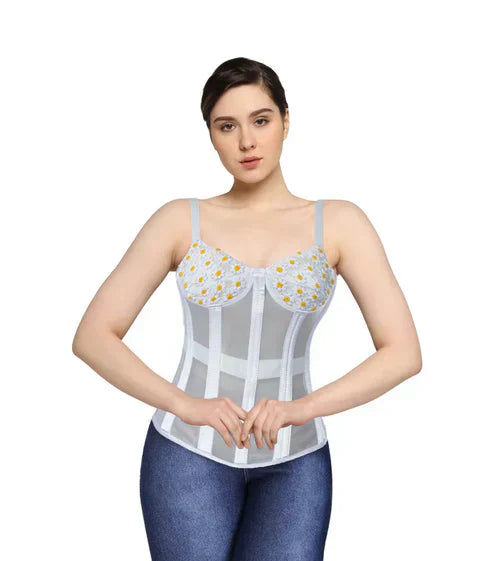
Find Your Ideal Shape: Tips to Select the Right Corset
Share
Discovering the ideal corset honours your own form and sense of style and is a powerful experience. It's important to comprehend how different corset styles fit different body types and what to take into account at different periods of life, whether your goal is dramatic curves or gentle shaping.

Knowing Your Body to Get the Ideal Fit
Understanding the individual dimensions and natural curves of your body is the first step in selecting the perfect corset. Think on these important aspects in addition to typical body shapes:
Torso Length: Waspie, normal, and longline corsets are available in different lengths. Measure the length of your seated torso (from the base of your neck to the crease where your legs meet your torso) to ensure the proper fit. While a corset that is too short may not provide the proper covering, one that is too long can cause discomfort when seated.
1. Waspie (Short): Provides excellent mobility and is best suited for torsos that are 7.5 inches or shorter while seated.
2. Standard (Regular): Fits torso lengths of at least 8 inches while sitting.
3. Longline (Long): Offers dramatic shape and considerable covering, requiring a sitting torso length of 11 inches or more.
Curve Levels: The amount of natural curvature in your body is known as your "curve levels," and corset makers frequently base their style designs on this information.
1. Apple or athletic forms that fit well and have a less organic shape are known as modern curves.
2. Romantic Curve: Enhances existing outlines in bodies with mild natural curves.
3. For those who naturally have well-defined hourglass bodies (proportionate hips and a tight waist), the hourglass curve is ideal.
4. Extreme Curve: For seasoned corset users looking for a really striking, exaggerated hourglass shape.
Important Measurements: Take precise measurements of your biggest chest, broadest hip, and natural waist (the smallest area, often above the belly button). It is normally advised to get a corset that is 4–7 inches smaller than your natural waist if you are under 38 inches, and 7–10 inches smaller if you are over 38.
Considerations for the Bust (for Overbust Corsets):
Overbust corsets provide support and shape for the hips, waist, and bust by covering the whole bust. They can be great alternatives to bras or statement items. An overbust can accentuate a smaller bust; for bigger busts, choose designs with gussets to provide volume and stop spills.
Underbust Corsets: Sit just below the bust, enhancing hip and waist definition while allowing the bust to be free. These are useful for waist training and "stealthing" (wearing under garments) since they are frequently simpler to fit, wear, and break in.
Body Shape-Based Corset Selection:
Hourglass Shape: A full-body corset, an hourglass curve design, or a defined waist will draw attention to your inherent curves.
Rectangular Shape (straight from bust to hip): A steel-boned corset with a defined waistline or a corset that shapes and defines the waist can provide the appearance of curves.
Pear-shaped (wider hips than shoulders): Longline or underbust corsets can hide the hips and draw attention to the waist.
Apple-shaped (weight centred on the stomach): High-waisted corsets, either overbust or underbust, can produce a beautiful waistline and offer support.
Athletic Build: The torso may be subtly enhanced and shaped using modern curve corsets.
Styles of Corsets and Their Uses:
Think on your own objectives and intended use in addition to body types:
Waist Training: Waist trainers and underbust corsets are made especially to gradually reduce the waist and shape the silhouette.
Fashion Statement: You can wear leather corsets, overbust corsets, or ornamental underbust designs as outerwear.
Posture Support: By promoting a straight back, many corsets can help with posture.
Discreet Shaping: Some underbust shapes, such as waspie corsets, are short enough to be readily hidden under clothes.
Age-Based Corset Classification: Crucial Factors to Consider
Because of continuous physically growth, age plays a big role when it comes to wearing corsets. Health professionals strongly recommend the following:
18 Years and Up: It is typically advised that corsets be worn by those who are at least 18 years old. Inappropriate use or wearing the incorrect size of a corset, which is intended to compress the body and shape the torso, can result in injury or health problems, particularly in developing bodies.
Children and Teens (Under 18): It is not advised for anybody under the age of 18 to wear traditional corsets. Younger bodies' internal organs, muscles, and skeletal structure are still developing, and the constant pressure and shaping that corsets provide can have an adverse impact on health. A child's development may be at danger even if a corset is worn loosely.
Psychological Considerations: Make sure that wearing a corset is a personal decision made for confidence and self-expression rather than in reaction to pressure from others to project a particular image.
Comfort, self-assurance, and showcasing your own attractiveness are the main considerations while selecting a corset. Prioritise taking accurate measurements, learning about various styles, and paying attention to your body at all times.
